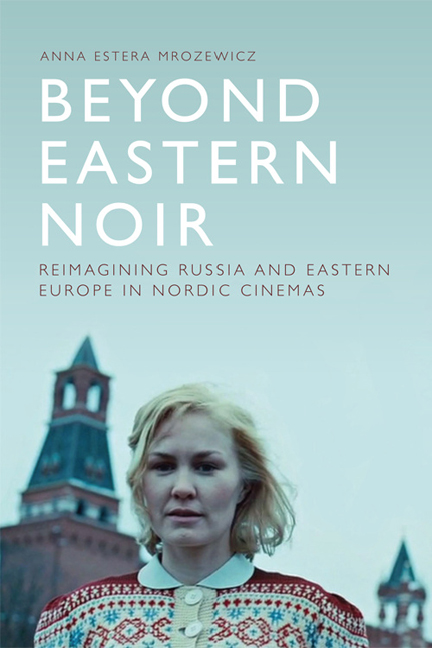Book contents
- Frontmatter
- Contents
- List of Figures
- Acknowledgements
- Introduction – The Iron Curtain Effect: Nordic Eastern Noir
- 1 Borders: Russia and Eastern Europe as a Crime Scene
- 2 Boundaries: Infiltrated Identities
- 3 The Baltic Boundary
- 4 Guilt and Shame in (Trans)national Spaces
- 5 Embodying the Fear of Russia: The Militarised Body
- 6 Polish Spectres in our House: Revisiting the Nordic Metaphor of the Home
- Afterword – Beyond Eastern Noir: Toward a New (Cinematic) Space
- Bibliography
- Filmography
- Index
Introduction – The Iron Curtain Effect: Nordic Eastern Noir
Published online by Cambridge University Press: 24 April 2021
- Frontmatter
- Contents
- List of Figures
- Acknowledgements
- Introduction – The Iron Curtain Effect: Nordic Eastern Noir
- 1 Borders: Russia and Eastern Europe as a Crime Scene
- 2 Boundaries: Infiltrated Identities
- 3 The Baltic Boundary
- 4 Guilt and Shame in (Trans)national Spaces
- 5 Embodying the Fear of Russia: The Militarised Body
- 6 Polish Spectres in our House: Revisiting the Nordic Metaphor of the Home
- Afterword – Beyond Eastern Noir: Toward a New (Cinematic) Space
- Bibliography
- Filmography
- Index
Summary
In the feature-length docudrama 1989 (Denmark 2014), by Danish director Anders Østergaard and Hungarian filmmaker Erszébet Rácz, the camera traces an East German couple's fateful border crossing from Hungary to Austria. The scene takes place in August 1989. Kurt-Werner Schulz, his partner and their child are attempting to escape from the Eastern Bloc. The scene is set at night, as the family walks in darkness through tall cornfields, led by a local Hungarian man. The severely limited visibility, wobbly hand-held camera focused solely on the nearest elements (corn leaves and the ground), and the sounds of breathing and footsteps, as well as the fact that the refugees do not understand their Hungarian guide, all create an atmosphere of disorientation and fear. Suddenly, warnings are shouted in the distance. Kurt-Werner is shot dead. A blurred frame shows him lying on the ground, after which it fades to black. A few weeks afterward, the Hungarian–Austrian border is opened, and a couple of months later, the Berlin Wall ‘falls’. Schulz thereby becomes ‘the last victim of the Iron Curtain’.
1989 is about the remarkable end to the Cold War. It is told from a contemporary perspective, marked by far-reaching reconstructions and the directors’ highly creative take on archival materials. The escape scene is reconstructed using cinematic means normally applied in fiction films. It adheres to well-known depictions of crossings of the border that defined European reality for almost fifty years and embodied the ‘geography of fear’ associated with the Cold War (see Loshitzky 1997: 277). The border crossing serves as a point of no return for the refugees and is the climax in the narrative structure of the film. It is connected with danger, pain and death. Moreover, the border denotes the edge of one world and the beginning of another, thus creating a clearly defined separation of the two sides. The use of the gun by the guards signifies the militarisation of the border and the prison-like confinement of those on the Eastern side. Ultimately, the border is invisible and yet acutely present.
The border is not simply a physical barrier. Rather, it is both real and imagined; the imagined is conveyed through cinematic means that enhance the act of border crossing both dramatically and emotionally (cf. Mrozewicz 2013b).
- Type
- Chapter
- Information
- Beyond Eastern NoirReimagining Russia and Eastern Europe in Nordic Cinemas, pp. 1 - 30Publisher: Edinburgh University PressPrint publication year: 2018



